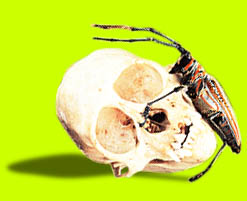
If Kafka's Gregor Samsa awoke "from uneasy dreams" in the late '90s, he'd find pop culture, rather than himself, transformed into "a gigantic insect" -- or, more precisely, into a gigantic insectary, overrun by six-legged omens of millennium. In the twilight of the 20th century, the insect archetype looms large in the pop unconscious. Bugs are everywhere, from the kiddy-friendly whimsies in Antz and A Bug's Life, to the extraterrestrial pests who are upstaging Whitley Streiber's little gray men in the uneasy dreams of millennial culture. Bald proctologists from Zeta Reticuli are giving way to the B-movie vermin in Men in Black and the mandible-gnashing arachnids in Starship Troopers.
Outside America's cineplexes, in the real world, alien "contactees" are beginning to report close encounters with bug-eyed monsters like the "Insectoid Queen of the Universe" who did the nasty with a "bespectacled young man," as mentioned in a 1997 issue of UFO Magazine. "No statistics are available yet," noted writer Jan Hester, "but more and more, praying mantises are showing up in the reports that feature beings other than Grays."
The alien invasion landed in 1996, when scorpion-like E.T.s saved the militia movement a fortune in ammonium nitrate by nuking the White House in Independence Day. That same year, kids' TV teemed with the not-so-creepy crawlers in Santo Bugito, Earthworm Jim, and The Tick. In 1997, MTV witnessed a vogue in bug-themed videos such as "Fly" by Sugar Ray, "Greedy Fly" by Bush, and the cockroach-infested "Breathe" by Prodigy.
The lower life forms have wormed their way into high culture as well, via novels like Bernard Werber's Empire of the Ants (1998), whose unlikely protagonist is the 327th male laid by the queen of a colony of Formica Rufa ants. In her new book of photographs, The Illusion of Orderly Progress, Barbara Norfleet offers, for our delectation, staged tableaux starring dead bugs: a grasshopper demagogue inciting an insect mob, two gleeful-looking tarantulas hanging some longhorn beetles.
So, what's bugging us? Most obviously, it's a millennium thing. Insects put a mythic face on the unknown -- in our case, the coming century. With their multifaceted eyes and obscenely working mouthparts, bugs are made-to-order bogeymen. The word "bug" derives from the Middle English "bugge," meaning terror, ghost, or hobgoblin. Swarming insects speak to us of social disintegration and the madness of crowds, like the frenzied mob in The Day of the Locust.
Then, too, the winged things that darken our mental skies, like the pestilential insects of Old Testament plagues, signal a world out of balance. Now, however, nature's equilibrium is threatened not by an angry god but by global warming and the destruction of natural habitats.
Or worse: Insects are harbingers of nuclear winter, "mound builders and gravediggers of the fin de siècle…the archetypal survivors of the holocaust," in the words of the cultural critic Hillel Schwartz. Insects can tolerate radiation levels that would kill most living things, a fact mythologized in the Cold War fable known to every baby boomer: A cockroach was supposedly the first thing moving at ground zero in Hiroshima.
But maybe we should read our millennial portents less literally. Freud suggested that dream imagery often involves visual puns; perhaps the insects scuttling across our inner movie screens are unconscious attempts to exorcise our fears of "bugs" of other sorts: the microorganisms in toxic McMeat, the brain-eating Ebola virus, or software glitches like the Millennium Bug -- termites in the foundations of a world built increasingly on zeros and ones. The rising specter of the insect may give shape to vague anxieties about the ever-smarter, ever-smaller technologies multiplying all around us. One day, we're told, the super-smart descendants of today's Web- crawling "spiders" and insect-like robots may challenge our position as big-brained lords of all we survey.
Meanwhile, a Darwinian struggle of another sort is taking place, even now. The power relations of post-industrial capitalism invite us to interpret our visions of insects as a metaphor for the emerging social order. Those drunk on the nectar of the New Economy, like the laissez-faire futurist Kevin Kelly, like to talk about wired workers networked into a corporate consciousness, or "hive mind"; of corporate "devolution," of "embracing the swarm." But to the downsized and the perma-temped, free-market parables about the joys of the hive ring false in a world increasingly stratified into low-wage drones and a Queen-Bee knowledge elite.
Speaking of parables, The Wall Street Journal recently noted that the office-furniture manufacturer Steelcase had installed a huge ant farm in the lobby of its New York offices. "Work is dramatically different than it used to be," an employee explained. "For more people, work and non-work are blending. Ants live to work, and work to live." Welcome to the ant farm.
Mark Dery has written about new media, fringe thought, and unpopular culture for The New York Times Magazine, Rolling Stone, The Village Voice Literary Supplement, Suck, and Feed. His collection of essays, The Pyrotechnic Insanitarium: American Culture on the Brink, was published by Grove Press in February, 1999.
